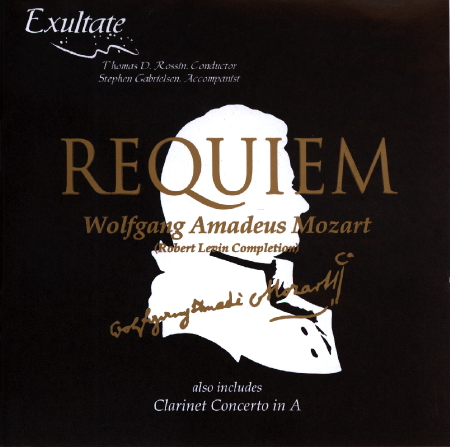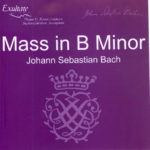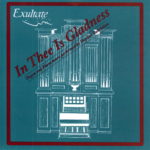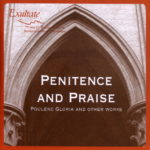Mozart Requiem – Levin Completion
$15.00
The Robert Levin completion of W. A. Mozart’s Requiem with Festival Chorus and Orchestra. Also Adagio from Clarinet Concerto.
Description
Click for sound sample: “Kyrie” (MP3).
Exultate’s full-orchestral recording of Requiem (KV626) by Wolfgang Amadeus Mozart includes a new movement ‘reconstructed’ from Mozart fragments. This performance employs a festival Chorus and Orchestra of over 100 musicians and soloists Anne Benner Storlie (soprano), Andrea Kovago (mezzo soprano), Justin Montigne (tenor) and Roy Kallemeyn (baritone).
Requiem (KV626) by W. A. Mozart (1756-91)
Robert Levin Completion
When Mozart died in the early morning hours of December 5, 1791, he left his final masterpiece, the Requiem, unfinished. Less than three months later, a completed score of the Requiem was delivered to its anonymous commissioner. How was the Requiem completed and how would Mozart have completed it had he lived? These mysteries have tantalized musicians for over two centuries.
Mozart received the commission to compose the Requiem from a mysterious ‘Gray Messenger’ in the summer of 1791. The Messenger paid half the commission in advance, but insisted on guarding his patron’s anonymity. Already committed to compose an opera for the Bohemian Court, Mozart left for Prague and didn’t begin work on the Requiem until his return in September. Before long he became convinced that the Messenger had come to warn him of his own mortality and that he was indeed composing the work for his own death. Concerned with this morbid fascination, his wife Constanze hid the score and forbade him to work on the Requiem for several weeks. But, shortly after resuming work in mid-November, Mozart became ill and took to his bed. He gathered a choir of friends around his bedside the afternoon of December 4th to sing the movements he had completed. He died less than twelve hours later.
In dire need of money to support herself and her two young sons, Constanze asked several noted composers to complete the Requiem so that she could collect the balance of the commission. Feeling unequal to the task, they declined. Mozart’s students Freystädtler and Eybler filled in some of the orchestration, but it fell to Franz Xaver Süssmayr to actually complete the score. Busy composing an opera of his own, Süssmayr rushed to meet the February deadline imposed by the mysterious Messenger. Able to imitate Mozart’s handwriting, Süssmayr forged Mozart’s signature on the title page and gave no indication that he had composed any part of the finished score.
Not content with collecting the commission, Constanze had two copies of the Requiem made for her own use. One she sold to King Friedrich Wilhelm II of Prussia. The other she later sold to publishers Breitkopf & Härtel of Leipzig in 1799. Learning of the pending publication, the anonymous patron finally revealed himself. Franz Count von Walsegg confessed that he had commissioned the work in honor of his late wife Anna, and had passed it off as his own composition at her memorial service. No longer able to claim authorship of the Requiem, he at least wanted a refund of his investment. He eventually compromised by accepting several pieces of music in compensation.
Those conversations with the publisher sparked a great controversy surrounding the Requiem. Süssmayr, who had kept his silence for eight years, wrote the publishers stating that the Sanctus, Benedictus, and Agnus Dei were entirely his own composition. Abbé Maximilian Stadler, one of Mozart’s close associates, carefully marked Count Walsegg’s score to indicate which handwriting was Mozart’s and which was Süssmayr’s. Still, Breitkopf & Härtel published the first edition attributing the entire work to Mozart. Some considered the work not worthy of Mozart, noting many errors in voice leading and also recognizing melodic material borrowed from Handel and Bach. Controversy as to the merits of the Requiem raged within the musical community for decades. In 1826, 23 years after Süssmayr’s death, André of Offenbach finally published an edition giving Süssmayr credit for his completion.
Half a century later, Johannes Brahms published a new edition of the Requiem in which he declined to fix any of Süssmayr’s errors. History, it seemed, had decided to accept the version delivered to Count Walsegg as definitive. Then, in 1960, musicologist Wolfgang Plath discovered previously unknown sketches for the Requiem in a collection of Mozart manuscripts at the Berlin Staatsbibliothek. These were clearly among the “scraps of paper” given Süssmayr by Constanze, which he had disregarded in his haste to meet the February deadline. The most important sketch indicated that Mozart intended the Lacrimosa to end in a fugue on the text “Amen.”
This was the final clue Harvard musicologist Robert Levin needed to create his own solution to the mystery of Mozart’s unfinished Requiem. A noted Mozart scholar, Levin had completed many Mozart fragments and specialized in historically informed performances of Mozart piano works. A lifetime of study allowed him to “get into Mozart’s mind.” He recognized in Mozart’s original score a structure, first suggested by fellow musicologist Christoph Wolff, of five major sections, each ending in a fugue. By completing the “Amen” fugue found in the Berlin sketch and revising Süssmayr’s amateurish “Hosanna” fugue, Levin restored Mozart’s original structure. Recognizing recurrences of Mozart’s original Requiem theme hidden in the movements attributed entirely to Süssmayr, Levin deduced that Süssmayr either had sketches, now lost, or oral instructions from Mozart guiding their composition. By retaining what he recognized as Mozart’s themes while revising Süssmayr’s compositional errors, Levin created a new and compelling completion of the Requiem.
The mystery of Mozart’s Requiem can never truly be laid to rest. With this inspired and historically accurate completion, Dr. Levin has offered one possible solution to the puzzle posed by Mozart over two centuries ago.
Notes by – Yvonne Grover
Soloists
Anne Benner Storlie, soprano, is an active singer and teacher in the Twin Cities. She holds a bachelor of music degree from Luther College, and a masters degree in vocal performance from the University of Minnesota. While at the U of M. Ms. Benner Storlie sang the roles of Sister Constance in Poulenc’s, The Dialogues of the Carmelites and Laurie in Copland’s, The Tenderland. Anne also sings with several local organizations including Minnesota Opera and Opera Twin Cities. She has also appeared with Minnesota Opera’s cast as a member of the chorus in their production of La Traviata.
Andrea Kovago, mezzo soprano, comes to us from Canada with a Bachelor of Music Degree in vocal performance from the University of Lethbridge, Alberta. She has recently completed her Master of Music degree in performance and a Certificate in Vocal Pedagogy at the University of Minnesota under the tutelage of Dr. Clifton Ware, and is currently pursuing her DMA in vocal performance at the U of M with Professor Lawrence Weller. She has performed many operatic roles, the most recent being the role of the Componist in the U of M opera production of Ariadne auf Naxos. Other roles include Meg Page from The Merry Wives of Windsor and Gertrude in Hansel and Gretel. Ms. Kovago has been a featured soloist in major choral works that include the Bach Mass in B minor and Magnificat, Mozart’s Requiem and Faure’s Requiem. Ms. Kovago teaches private voice lessons while holding an appointment as a vocal instructor for both group voice classes and applied lessons at the University of Minnesota.
Justin Montigne, tenor, is pursuing a doctoral degree in voice at the University of Minnesota where he is a member of the Ted Mann Vocal Quartet. He received his bachelors degree from Drake University and masters degree from the U of M. He has been a winner at both the state and regional levels of the National Teachers of Singing auditions and is a frequent soloist and recitalist in the Twin Cities area. While at Drake, Mr. Montigne sang the title role in Britten’s Albert Herring, and at the University of Minnesota has sung Don Curzio in The Marriage of Figaro, the Father Confessor in Dialogues of the Carmelites, Mr. Splinters in The Tender Land, Alessandro in Il re pastore, Slender in The Merry Wives of Windsor and Brighella in Ariadne auf Naxos. Concert appearances include the tenor solos in Haydn’s Creation and Handel’s Messiah, as well as Ottorino Respighi’s Laud to the Nativity, Britten’s Serenade and Arvo Pärt’s Litany. Mr. Montigne appeared this past summer as a chorister and masterclass soloist with the Oregon Bach Festival, and also serves as a section leader with the Mount Olivet Lutheran Church Senior Choir. He teaches voice at Eastview High School in Apple Valley. Mr. Montigne will be singing the role of Danceny in the University of Minnesota’s production of Conrad Susa’s The Dangerous Liasons, and will be making his professional operatic debut as Ernesto in Don Pasquale with the Western Plains Opera in May.
Roy Kallemeyn, baritone, earned a Bachelor of Music Degree in Vocal Performance from St. Olaf College. Currently studying voice with Barbara Kierig, Roy has performed extensively throughout the Twin Cities. Recently he has appeared as Euthycles in La Belle Helene, Lazar Wolf in Fiddler on the Roof, Fakir in the Secret Garden, and in the Minnesota Orchestra’s productions of Candide and Amahl and the Night Visitors. He has also sung with the North Star Opera Company, Minnesota Opera, Ashland Productions, New Breath Productions, Gilbert & Sullivan Very Light Opera Company and the Warland Symphonic Chorus, encompassing roles such as Cascada in Merry Widow, Ali in Italian Girl in Algiers, Besac in New Moon, Count Almaviva in the Marriage of Figaro, and El Gallo in The Fantasticks. He has appeared as guest soloist in the Seven Last Words of Christ, performed in several Broadway revues involving the music of Richard Rogers, Stephen Sondheim and Cole Porter, and enjoys performing tunes with Ashland Production’s Big Band. His activities in television extend to commercials for Best Buy, Great Clips, Miller Lite, and Becker’s Furniture World. He has also appeared on Comedy Central’s Let’s Bowl and in the movies Joe Somebody and Mighty Ducks II.
You must be logged in to post a review.
This site uses Akismet to reduce spam. Learn how your comment data is processed.






Reviews
There are no reviews yet.